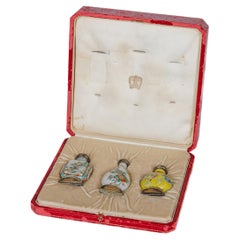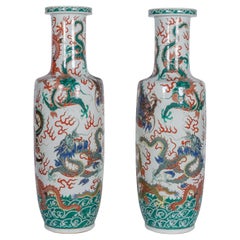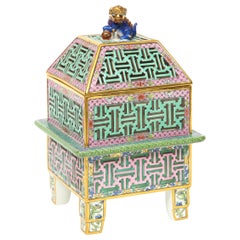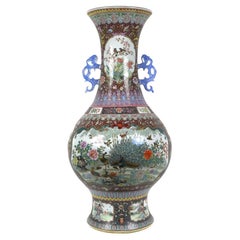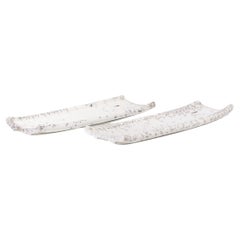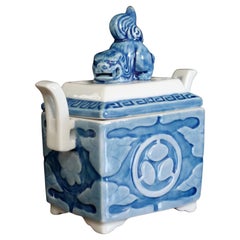Solomon Treasure Ceramics
to
4
4
1
2
1
1
4
4
1
1
1
2
2
2
2
1
4
4
4
1
1
Cartier Silver-Mounted Chinese Porcelain Snuff Bottles in Original Box
By Cartier
Located in Queens, NY
An Exquisite Suite of Three French Silver-Mounted Chinese Porcelain Snuff Bottles with Coral and Sapphire Adornments by Cartier, Presented in Original Fitted Box
This exceptional su...
Category
Antique 19th Century French Qing Ceramics
Materials
Coral, Silver
A Highly Rare Pair of Monumental Qing Dynasty Rouleau Porcelain "Dragon" Vases
Located in Queens, NY
A Highly Rare Pair of Monumental Qing Dynasty Rouleau Porcelain "Dragon" Vases
A Masterful Display of 19th Century Chinese Artistry:
The mid-19th century Qing Dynasty marked a period of artistic innovation and imperial grandeur, as exemplified by this rare and monumental pair of Rouleau vases. These exceptional porcelain works, notable for their commanding size and vibrant palette, are a testament to the unparalleled craftsmanship that flourished during this era. Embellished with a dynamic tableau of dragons rendered in bold hues of red, green, blue, brown, and yellow, these vases embody both artistic brilliance and the deep cultural symbolism woven into Chinese decorative arts.
Artistic Excellence and Symbolism:
At the heart of these magnificent vases lies a visual narrative that channels the power and mystique of the dragon, a central motif in Chinese culture symbolizing imperial authority, strength, and cosmic energy. The intricate depiction of dragons in motion, intertwined amidst stylized ocean waves, conveys a sense of fluidity and dynamic movement. Each color used—the crimson reds, verdant greens, striking blues, earthy browns, and golden yellows—has been meticulously applied, reflecting a mastery of the high-fired, polychrome enameling techniques perfected during the Qing Dynasty.
The Rouleau form, with its cylindrical body, short neck, and slightly flared mouth, was a favored shape for large-scale vases in the 18th and 19th centuries. The form’s structured elegance allowed for expansive decorative panels, serving as an ideal canvas for intricate, multi-layered designs. This pair demonstrates how artisans skillfully balanced the flowing movement of the dragons with the rhythmic motifs of waves, resulting in a harmonious composition that engages the viewer from every angle.
Craftsmanship and Technique:
These vases represent the pinnacle of porcelain artistry achieved under the Qing Dynasty, showcasing techniques that reflect centuries of refined craftsmanship. The precision in the application of overglaze enamels and the expert manipulation of kiln temperatures to achieve vibrant and consistent coloration are indicative of the expertise within the imperial kilns. The dragons' scales, rendered with remarkable detail, create a textured effect that contrasts beautifully with the smooth, undulating waves, enhancing the three-dimensional quality of the design.
The depth of color and the crisp delineation of each element point to a rigorous and time-intensive process. These qualities signify the involvement of highly skilled artisans who adhered to the imperial standards set by the royal court, ensuring that each piece was a fitting representation of the empire’s wealth and cultural prowess.
Historical and Cultural Significance:
Vases of this caliber were not merely decorative; they were imbued with profound symbolic meaning and often commissioned for imperial use or gifted as prestigious diplomatic offerings. The dragon motif, deeply embedded in Chinese folklore and philosophy, was associated with the emperor himself—known as the "Son of Heaven"—and symbolized his divine right to rule. These vases also reflect the Qing Dynasty's flourishing export trade and the global fascination with Chinese porcelain during the 19th century. European collectors and royal patrons prized such pieces for their artistry and the exoticism they represented, contributing to a legacy that elevated Chinese porcelain to a revered status in the annals of decorative art history.
Provenance and Collectability:
The extraordinary scale, exceptional craftsmanship, and rarity of this pair establish them as museum-quality works. Such vases would have held a place of honor in a palace or wealthy estate, reflecting not only the owner’s status but also an appreciation for the profound cultural and artistic traditions of China. Their provenance—potentially tied to an imperial commission or significant historical collection—underscores their importance as objects of study and admiration.
Provenance:
Private American Collection, acquired in London, circa 1905.
Thence by descent to the current owners
Solomon Treasure...
Category
Antique Mid-19th Century Chinese Qing Ceramics
Materials
Porcelain
Rare Meissen Marcolini Porcelain Chinoiserie Incense Burner Vase and Cover
By Meissen Porcelain
Located in Queens, NY
A rare Meissen Marcolini Porcelain Chinoiserie incense burner vase and cover, made for the Chinese market, circa 1800, blue cross swords and star mark, Pressnummer 58
A Museum Quality Piece.
Painted in the sought after famille rose palette with sprigs of indianische Blumen and enriched in gilding, the simulated pierced body supported by four feet painted with stylized dragons, the pierced cover with a Buddhist lion finial.
10" high x 6" wide x 6" deep
The shape of this piece, which appears to be unrecorded in the literature, is inspired by similar Chinese porcelain censers from the Qing Dynasty, Kangxi Period (1654-1722). An example in the Palace Museum, Beijing, is illustrated by Li Yi-hua in Qing Porcelain of Kangxi, Yongzheng and Qianlong Periods from the Palace Museum Collection, Hong Kong, 1989, pl. 65. Another in the British Museum, London (museum no. PDF, A.812) is catalogued as a perfume-holder.
These porcelain examples are in turn inspired by ancient Chinese bronzes from both the Shang (1600-1046 BC) and the Zhou (1046-246 BCE) dynasties, an example of which was sold anonymously by Christie's New York, 22 March 2019, lot 1601. This chain of inspiration tracking backwards from the 19th century to antiquity provides a clear example of how ceramics, and indeed other mediums, are able to influence and motivate the works of later generations.
For a Meissen porcelain snuff...
Category
Antique Late 18th Century German Chinoiserie Ceramics
Materials
Porcelain
Monumental Chinese Famille Rose Porcelain "Peacock" Palace Vase
Located in Queens, NY
A monumental Chinese famille rose porcelain "Peacock" palace vase, Republic period.
Magnificent quality and palace sized Chinese hu-form vase with side h...
Category
Late 20th Century Chinese Qing Ceramics
Materials
Porcelain
Related Items
Japanese Modern LAAB 2 Incenso Incense Holders Raku Ceramics White Crackle
By LAAB Milano
Located in monza, Monza and Brianza
Incenso set
An extraordinary addition to a contemporary decor for a stunning visual allure, this set of two incense holders features a raw, porous shape deftly handcrafted following the Japanese technique of naked Raku ceramic firing...
Category
21st Century and Contemporary Italian Modern Ceramics
Materials
Ceramic
$224 / item
H 0.71 in W 3.15 in D 10.24 in
Old Japanese Porcelain Lidded Incense Burner in the Original Box
Located in Norton, MA
Old Japanese porcelain lidded incense burner in the original box
The lid with the lion, two pierced handles on each side, and four feet at the four corners to stand.
This is an old...
Category
Mid-20th Century Ceramics
Materials
Porcelain
Antique Blue White Chinese Porcelain Qing Dynasty Kangxi Period Dragon Vase 1680
Located in Portland, OR
A very large & rare antique Chinese Qing Dynasty Blue & White Porcelain Rouleau dragon vase, Kangxi period (1662-1722), the vase dating to the late 1600s.
The vase of slightly tapere...
Category
Antique 1680s Chinese Qing Ceramics
Materials
Porcelain
$6,800
H 19 in Dm 6 in
Petite Famille Rose Chinese Ginger jar, c. 1900
Located in Chicago, IL
During the 18th century, Europeans provided an eager market for Chinese export porcelain, especially the colorful and fanciful ware known as “famille rose.” Named for a palette of op...
Category
Early 20th Century Chinese Qing Jars
Materials
Porcelain
Large Qing Dynasty Famille Rose Porcelain Ginger Jar
Located in Grythyttan, SE
Antique ginger jar with lid, porcelain, China, Qing Dynasty, 19th century, pumpkin-shaped featuring boys at play in Famille Rose colors.
This elegant piece, an antique ginger jar...
Category
Antique Late 19th Century Chinese Qing Ceramics
Materials
Enamel
Chinese Porcelain Powder Blue Gilt Dragon Charger, Late Qing Dynasty, China
Located in Austin, TX
A magnificent Chinese powder blue glazed porcelain charger with painted gilt decoration, late Qing Dynasty, circa 1900, China.
The large and impressive Chinese porcelain charger gla...
Category
Antique Early 1900s Chinese Qing Ceramics
Materials
Porcelain
$6,800
H 2.63 in Dm 16.25 in
Large Chinese Qing Dynasty Wucai Porcelain Dragon Bowl, 19th Century
Located in Austin, TX
A large Chinese Qing dynasty porcelain wucai (five color) glazed bowl painted in underglaze blue and overglaze red, green, and yellow upon a pure white ground, and featuring a design...
Category
Antique Late 19th Century Chinese Qing Ceramics
Materials
Porcelain
Japanese Modern Incenso Incense Holders Raku Ceramics Green Copper
By LAAB Milano
Located in monza, Monza and Brianza
An extraordinary addition to a contemporary decor for a stunning visual allure, this incense holder features a raw, porous shape deftly handcrafted and fire with the Raku Japanese...
Category
21st Century and Contemporary Italian Modern Ceramics
Materials
Ceramic
$129 / item
H 0.71 in W 3.15 in D 10.24 in
Japanese Contemporary Ko-Imari Gold Blue Porcelain Koro Incense Burner
Located in Takarazuka, JP
Stunning contemporary Japanese Ko-Imari style porcelain koro or incense burner or jewelry box, hand painted on a beautifully shaped round body in cobalt blue, red and green and gener...
Category
21st Century and Contemporary Japanese Meiji Jewelry Boxes
Materials
Gold
19th Century Chinese Famille Verte Porcelain Garlic Mouth Vase, Kangxi Marks
Located in Ottawa, Ontario
The globular body finely decorated with hand applied enamels depicting nobles taking tea surrounded by attendants and small children. The slender neck rising to a bulbous mouth (seemingly ground), the underside of the base showing small firing cracks and blue under-glaze double ring Kangxi marks...
Category
Antique 19th Century Chinese Qing Ceramics
Materials
Porcelain
$1,200
H 9.5 in Dm 4.5 in
Pair Chinese Porcelain Rouleau Shape Famille Vert Imperial Subject Vases, 1800s
Located in New York, NY
A Pair of Chinese Porcelain Rouleau Form Famille Vert Imperial Subject Vases, 1800s
Step into the realm of Chinese porcelain mastery with this captivating pair of Chinese Porcelain Rouleau Form Famille Vert Imperial Subject Vases. These remarkable vases transport you to a world where art and storytelling intertwine, inviting you to embark on a visual journey through vibrant landscapes and captivating narratives.
The artistry of these vases is truly enchanting. Hand-painted scenes unfold before your eyes, depicting majestic mountains, fresh green pine trees, and figures with expressions that evoke a sense of wonder. The resplendent and colorful robes add a touch of elegance to the composition with colors ranging from rich red and emerald green to mesmerizing blue, aqua, and chartreuse hues, creating a harmonious palette that captivates the senses.
The middle of the chimney-shaped vase-necks showcase a hand painted...
Category
Antique 1870s Chinese Qing Ceramics
Materials
Porcelain
$12,800 / set
H 18 in Dm 8 in
Pair Chinese Dragon Fish Glazed Porcelain Vase, Qing Dynasty, 19th-20th Century
Located in Austin, TX
A fantastic pair of Chinese molded and glazed biscuit porcelain vases with leaping dragon fish or makara, late Qing dynasty, circa 1900.
The vases of balu...
Category
Antique Early 1900s Chinese Qing Ceramics
Materials
Porcelain
$4,500 / set
H 6.5 in W 4 in D 2.5 in
